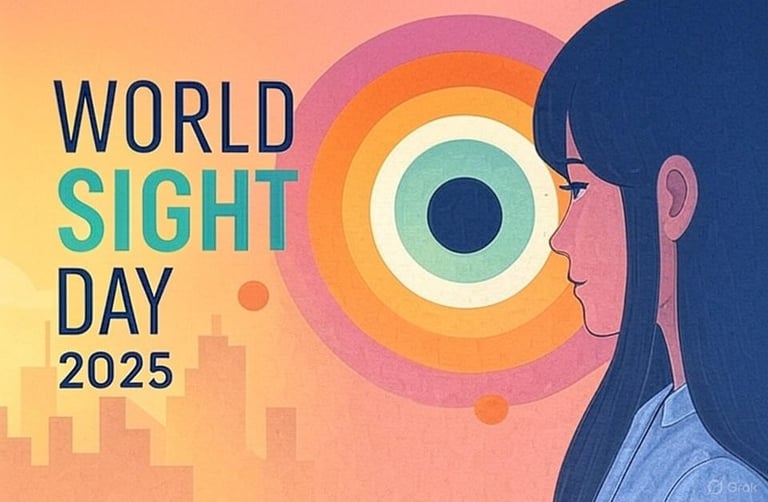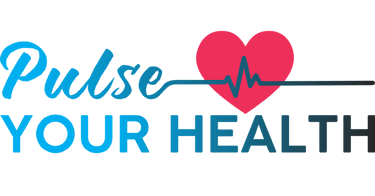Stay updated on what is trending in health. Discover tips and resources for a healthier, balanced life.
World Sight Day 2025: Love Your Eyes, Protect Your Vision
Celebrate World Sight Day 2025 on the 9th of October. Learn about the “Love Your Eyes” campaign, eye health tips, and global efforts to prevent vision loss.
Dr. S. Ali
10/9/20256 min read
Every year, on the second Thursday of October, people around the world pause to focus on eye health and vision care. In 2025, World Sight Day falls on October 9.
This day isn’t just symbolic — it’s a global call to action. It’s a reminder that vision matters, that many people still lack access to essential eye care, and that prevention and early detection can make a huge difference in someone’s life.
What’s the 2025 Theme?
The theme for World Sight Day 2025 is “Love Your Eyes.”
This year, the campaign emphasizes putting people at the heart of eye health. The message is: everyone should prioritize their vision, while advocating for eye care services that are accessible, available, and affordable for all.
A few key campaign components:
Every Story Counts: collecting and sharing real-life stories to highlight why eye health matters for individuals, not just statistics.
Global Challenge: bringing eye screenings to political decision-makers so they see firsthand the importance of vision care.
Photo Competition: celebrating 10 years of visual storytelling about eye health.
Why World Sight Day Matters
1. A Massive Global Need
More than 2 billion people worldwide are estimated to have some form of vision impairment, and roughly 1 billion of these are in cases that could have been prevented or treated.
That means many are living with reduced quality of life — not being able to read, work, study, or navigate safely — simply because they didn’t have access to the right eye care.
2. Eye Care Inequities
In many low- and middle-income areas, basic eye care services, glasses, cataract surgery, and specialist care are still out of reach for large populations.
World Sight Day shines a spotlight on these inequalities and encourages policies, investments, and partnerships to close these gaps.
3. Prevention is Powerful
Many causes of vision impairment — such as uncorrected refractive error, cataracts, glaucoma, diabetic retinopathy — are treatable or manageable if caught early. Promoting awareness helps people get timely care.
World Sight Day also reinforces the idea that eye health is part of overall health — it’s not just about vision, but about well-being, productivity, education, and inclusion.
Everyday Habits to Protect Your Vision
Eye health isn’t just something to think about once a year on World Sight Day — it’s something we build through small, consistent habits. Most causes of vision loss are preventable or manageable when you take care of your eyes early. Here are a few simple but powerful ways to keep your eyes healthy every day.
1. Schedule Regular Eye Exams
Getting your eyes checked isn’t only for people who already wear glasses. Even if you have perfect vision, routine exams can catch early signs of eye diseases like glaucoma, diabetic retinopathy, and macular degeneration — conditions that often show no symptoms until significant damage has occurred.
Make it a habit to see your eye doctor at least once every 1–2 years, or more often if you have diabetes, high blood pressure, or a family history of eye disease.
2. Protect Your Eyes from the Sun
Just like your skin, your eyes need UV protection too. Long-term exposure to sunlight can increase your risk of cataracts and macular degeneration. Choose UV-blocking sunglasses whenever you’re outdoors — even on cloudy days — and wear a wide-brimmed hat for extra protection.
3. Take Screen Breaks
We spend more time on screens than ever before — from computers to phones to TVs. All that close-up work can cause digital eye strain, leaving your eyes tired, dry, or blurry.
Try the 20-20-20 rule: every 20 minutes, look at something 20 feet away for at least 20 seconds. Blink often and adjust your screen brightness and distance to reduce glare and fatigue.
4. Eat for Your Eyes
Nutrition plays a bigger role in vision than most people realize. A diet rich in antioxidants, omega-3 fatty acids, and vitamins A, C, and E can protect your eyes from age-related damage.
Focus on colorful fruits and vegetables like carrots, spinach, kale, oranges, and blueberries, and include fish like salmon or tuna for healthy fats that support the retina.
5. Stay Physically Active
Regular exercise improves blood circulation, which helps oxygen and nutrients reach your eyes. It can also lower your risk of diabetes and high blood pressure — two of the biggest contributors to vision loss. Even a brisk 30-minute walk most days can make a difference.
6. Avoid Smoking
Smoking increases the risk of developing serious eye diseases such as macular degeneration, cataracts, and optic nerve damage. Quitting smoking is one of the best things you can do not just for your lungs, but for your sight.
7. Manage Chronic Conditions
If you have conditions like diabetes, hypertension, or thyroid disease, keeping them under control protects your eyes too. High blood sugar and blood pressure can damage delicate blood vessels in the eyes over time, leading to permanent vision problems.
8. Practice Good Hygiene with Contact Lenses
If you wear contact lenses, always handle them with clean hands, and never sleep or swim in them unless approved by your doctor. Replace lenses and cases regularly to prevent serious infections like keratitis.
How You Can Get Involved
You don't have to be an eye doctor to participate. Here are ideas for individuals, clinics, schools, and organizations:
Schedule a sight test — use World Sight Day as your reminder to get your eyes checked and encourage family and friends to do the same.
Share your story — if vision loss or eye disease has touched your life, sharing that experience helps others connect and understand.
Host or support screenings — partner with eye health groups to offer free or low-cost eye exams in your community.
Advocate locally — reach out to schools, local government, or health departments to prioritize eye care services.
Use social media — post, tag, use hashtags like #WorldSightDay, #LoveYourEyes, #EveryStoryCounts to amplify messages.
Participate in the photo competition — use visual storytelling to spotlight why eye care matters.
Organizations are encouraged to plan ahead, using toolkits and resources from IAPB and partners.
In the U.S., Prevent Blindness will host a free vision screening and a congressional briefing on October 9 as part of the day’s events.
A Brief History and Key Facts
Origins: World Sight Day was first launched in 1998 by the International Agency for the Prevention of Blindness (IAPB) and later adopted by WHO and many partners.
Coordination: IAPB leads the global campaign, working with ministries, NGOs, eye health organizations, and advocacy groups.
Date: Always observed on the second Thursday in October.
Campaign Tools: IAPB publishes toolkits, theme materials, slide decks, social media kits, and campaign guides to support local efforts.
What Makes 2025 Special?
2025 marks the continued emphasis on human stories — showing that behind every statistic is a person whose life was affected by vision or lack of care.
The campaign is pushing for policymakers to experience or witness vision screening so they understand the issue first-hand.
The photo competition is celebrating a decade of visual storytelling about eye health.
Innovations Shaping the Future of Eye Care
Eye care is advancing faster than ever. From AI-powered retinal scans that can detect diseases like diabetes and glaucoma early, to smart contact lenses that may one day monitor eye pressure or blood sugar, technology is transforming how we protect our vision.
Tele-ophthalmology — remote eye exams using smartphone cameras and cloud platforms — is helping people in rural and underserved areas get diagnosed and treated sooner.
Meanwhile, researchers are exploring gene therapies for inherited retinal diseases and bionic eyes that can partially restore sight to people with severe vision loss.
World Sight Day isn’t just about what we can do now — it’s also about imagining a future where no one loses vision unnecessarily.
Why “Love Your Eyes” Is More Than a Slogan
The 2025 theme, “Love Your Eyes,” is really about changing how we think about vision.
It’s not just about treating problems when they happen — it’s about appreciating the role our eyes play in everything we do, from reading and driving to recognizing faces and enjoying sunsets.
Taking care of your eyes means taking care of your independence, well-being, and quality of life. And that’s exactly what World Sight Day hopes to remind everyone, everywhere.
Celebrate World Sight Day 2025 on the 9th of October. Learn about the “Love Your Eyes” campaign, eye health tips, and global efforts to prevent vision loss.
Related Articles:
1. Diabetes and Your Eyes: What You Need to Know to Preserve Your Sight
2. Best Foods for Healthy Eyes: Nutrition Secrets for Better Vision
3. 20-20-20 Rule: A Game-Changer for Health and Productivity
4. Understanding Cataracts: A Guide to Clear Vision
Sources
1. International Agency for the Prevention of Blindness (IAPB) Official World Sight Day Campaign 2025: “Love Your Eyes”
https://www.iapb.org/world-sight-day
2. World Health Organization (WHO) Vision and Eye Care Fact Sheets
https://www.who.int/health-topics/blindness-and-vision-loss
3. Orbis International World Sight Day 2025: Global Efforts to End Avoidable Blindness
https://www.orbis.org/en/world-sight-day-2025
4. Prevent Blindness (U.S.) World Sight Day 2025 Events and Resources
https://preventblindness.org/calendar/2025-world-sight-day
5. Vision 2020: The Right to Sight / IAPB Archive Global Vision Initiatives and Impact
https://www.iapb.org/vision-2020/
6. International Council of Ophthalmology (ICO) Global Eye Health Reports and Research
https://icoph.org
7. American Academy of Ophthalmology (AAO) Eye Health Tips and Public Awareness
https://www.aao.org/eye-health
8. National Eye Institute (NEI – U.S. NIH) Facts About Vision and Eye Diseases
https://www.nei.nih.gov/learn-about-eye-health


Pulse Your Health
Empowering you to achieve your health goals.
Contact
© 2025. All rights reserved.
Disclaimer: The content on this website is for informational purposes only and is not medical advice. Always seek the advice of your physician or other suitably qualified healthcare professional for diagnosis, treatment and your health related needs.
